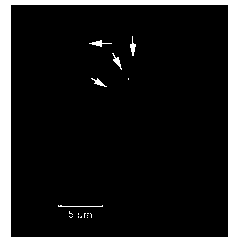Fluorescence in situ hybridization method for positioning 45S rDNA on plant chromosome
A fluorescence in situ hybridization and chromosome technology, applied in the fields of cytogenetics and molecular biology, can solve the problems of cumbersome steps, laborious experimental results, time-consuming, etc., and achieve the effects of simplified pretreatment steps, simple components, and simple methods.
- Summary
- Abstract
- Description
- Claims
- Application Information
AI Technical Summary
Problems solved by technology
Method used
Image
Examples
Embodiment 1
[0053] FISH Localization of 45S rDNA on Metaphase Chromosomes of Rye
[0054] 1. Chromosomal Specimen Preparation
[0055] (1) After the rye seeds germinate, the root tip grows to 0.5cm.
[0056] (2) Cut off the root tip and pretreat it with saturated p-dichlorobenzene aqueous solution for 5 hours at room temperature.
[0057] (3) The root tip was hypotonic with 0.075mol / L potassium chloride hypotonic solution for 30 minutes, and then fixed with 3:1 (methanol: glacial acetic acid) fixative for 20 minutes.
[0058] (4) Wash three times with distilled water, 5min each time, to fully wash away the fixative.
[0059] (5) Using 2.5% (w / w) pectinase and cellulase mixed in a weight ratio of 1:1, the root tip was dissociated at 37°C for 1 hour.
[0060] (6) Wash off the enzyme solution with distilled water, hypotonic with 0.075mol / L potassium chloride hypotonic solution for 30min, and fix with 3:1 methanol: glacial acetic acid fixative for 20min.
[0061](7) Prepare chromosome spe...
Embodiment 2
[0085] FISH Location of 45S rDNA on Metaphase Chromosome of Poplar
[0086] 1. Chromosomal Specimen Preparation
[0087] (1) Cut poplar branches and soak them in tap water, change the water every day until the root tip grows to 1cm.
[0088] (2) Cut off the root tip and pretreat it with saturated p-dichlorobenzene aqueous solution for 3 hours at room temperature.
[0089] (3) The root tip was hypotonic with 0.075mol / L potassium chloride hypotonic solution for 30 minutes, and then fixed with 3:1 (methanol: glacial acetic acid) for 40 minutes.
[0090] (4) The root tip was washed three times with distilled water, each time for 5 minutes, and the fixative was fully washed away.
[0091] (5) Using 2.5% (w / w) pectinase and cellulase mixed in a weight ratio of 1:1, the root tip was dissociated at 37°C for 1 hour.
[0092] (6) Wash off the enzyme solution with distilled water, hypotonic with 0.075mol / L potassium chloride hypotonic solution for 30min, and fix with 3:1 methanol: gla...
Embodiment 3
[0116] Embodiment 3: comparative embodiment
[0117] classic in situ hybridization
[0118] FISH localization steps of 45S rDNA on rye metaphase chromosome:
[0119] 1. Chromosomal Specimen Preparation
[0120] (1) After the rye seeds germinate, the root tip grows to 0.5cm.
[0121] (2) Cut off the root tip and pretreat it with saturated p-dichlorobenzene aqueous solution for 5 hours at room temperature.
[0122] (3) The root tip was hypotonic with 0.075mol / L potassium chloride hypotonic solution for 30 minutes, and then fixed with 3:1 (methanol: glacial acetic acid) for 20 minutes.
[0123] (4) The root tip was washed three times with distilled water, each time for 5 minutes, and the fixative was fully washed away.
[0124] (5) Using 2.5% (w / w) pectinase and cellulase mixed in a weight ratio of 1:1, the root tip was dissociated at 37°C for 1 hour.
[0125] (6) Wash off the enzyme solution with distilled water, hypotonic with 0.075mol / L potassium chloride hypotonic solu...
PUM
 Login to View More
Login to View More Abstract
Description
Claims
Application Information
 Login to View More
Login to View More - R&D
- Intellectual Property
- Life Sciences
- Materials
- Tech Scout
- Unparalleled Data Quality
- Higher Quality Content
- 60% Fewer Hallucinations
Browse by: Latest US Patents, China's latest patents, Technical Efficacy Thesaurus, Application Domain, Technology Topic, Popular Technical Reports.
© 2025 PatSnap. All rights reserved.Legal|Privacy policy|Modern Slavery Act Transparency Statement|Sitemap|About US| Contact US: help@patsnap.com



